As the popularity of healthy, ethnic cooking home grows, our spice rack should expand to accommodate the seasonings give vegan dishes their unique characters. Volumes can be written on the healing aspect of herbs (in fact see our review of the terrific book, Healing Spices), the focus here is culinary. This section will give a brief overview of those seasonings most commonly used to flavor global whole food recipes.
BUYING, STORAGE, AND USAGE TIPS
- When buying herbs and spices by weight, buy only what will fit into an average-size spice jar. In other words, don’t stock up. Most go a very long way and are at their optimal flavor for up to a year, after which they begin losing their potency.
- Keep dried herbs and spices in a place in your kitchen that is away from heat and moisture.
- When substituting fresh herbs for dry, use about three times the amount of fresh herb as the dry.
- Introduce dried herbs and spices into your recipe as early in the cooking process as possible, so that they have a chance to develop flavor. Add fresh herbs toward the middle or even the end of the cooking if you’d like to retain their pronounced flavor.
ANISE or ANISEED is an aromatic spice that imparts a distinct flavor of licorice and is commonly used to make the liqueurs ouzo, anisette, and pernod. Anise is used in cookies and cakes, and a sprinkling of the seeds adds an unusual twist to fruit salads, particularly those utilizing citrus fruits. Try adding anise to fruit pies, relishes and chutneys, and dark breads. In Indian cuisine, anise is occasionally used in pilafs and braised dishes.
ALLSPICE is the hard berry of an evergreen tree native to the West Indies and Central America. Its name quite possibly reflects its flavor, which as a hint of the flavors of several spices, including cinnamon, nutmeg, and cloves. It is most commonly sold in ground form, though the whole berry is available in spice shops and is used in pickling and to flavor broths and marinades. The mildly spicy-sweet flavor of ground allspice enhances apple desserts, banana breads, spice cakes, cookies, chutneys, and recipes utilizing squash, pumpkin, or sweet potatoes.
BASIL is one of the most relished of herbs and one that has an important place in herbal lore and legend, spanning many ages and cultures. In the summer, the intoxicating scent of fresh sweet basil fills produce markets, and its brief season should be fully enjoyed. Though basil makes an excellent dried herb whose sweet-and-spicy flavor is welcome in many dishes, the result is very different when using it fresh. Fresh basil is the main component of pesto sauces and has a special affinity with tomato-based pasta sauces and fresh tomato salads (as in the classic tomato, mozzarella, and basil salad). Dried basil is good in soups, marinades and vinaigrettes, grain dishes, herb breads, and omelets. It may also be used to flavor tomato sauces when fresh basil is unavailable.
BAY LEAVES are the whole, dried leaves of the bay laurel tree and are most useful in long-simmering recipes, such as soups and stews, where their flavor has a chance to permeate. Its warm, somewhat “woodsy” character lends itself especially well to recipes that contain tomatoes, beans, corn, and potatoes.
CARAWAY SEEDS, the seeds of a biennial plant native to Europe, have a sharp, distinctive taste that puts them in the category of flavorings that are either loved or intensely disliked. They are best known for adding zest to rye and pumpernickel breads; try expanding their use to flavor recipes emphasizing potatoes or other root vegetables (such as parsnips or turnips) as well as cabbage varieties.
CARDAMOM, derived from a plant native to India, is available in whole or ground form. Bought whole, the seed pods must be opened, revealing several small, dark seeds. These aromatic seeds have a flavor that is hard to describe, but is appropriate for both sweet and savory dishes. The whole seeds lend an aromatic quality to grain dishes, especially fruit-and-nut grain pilafs as well as curries containing potatoes or peas. In ground form, cardamom may be used in the same sort of baked goods in which you’d use allspice—squash, pumpkin, or sweet-potato pies, for example, or batter breads. It may also be used to season those same vegetables when they are served as side dishes.
CAYENNE PEPPER is perhaps the hottest of ground spices, ground and dried from a very hot variety of a pepper of the capsicum genus. A small amount goes a long way and is used to give fiery flavor to Mexican, Indian, and some Southeast Asian cuisines and is also useful in spicing Creole and Cajun specialties. Cayenne pepper lends itself to vegetable or bean stews, curries, chilies, spicy cold noodle dishes, and hot-and-sour dishes.
CHILI POWDER is a blend of spices with dried, ground red chili pepper as its base. The blends available in Spanish groceries, spice shops, and natural-food stores will be more robust and aromatic than those bought in supermarkets; you will also be able to choose from among milder and hotter varieties. The consistent ingredients, along with chili pepper, often include cumin, oregano, and garlic, but may also contain salt and other seasonings as well. Use chili powder to flavor bean stews and soups. It’s a logical addition to tomato-based enchilada sauces, but try adding it to a tomato-based pasta sauces as well to add a warm note. Chili powder is good in some Oriental-style sauces such as peanut or sesame sauce for noodles.
CHIVES are a member of the lily family, whose relatives include onions, scallions, and garlic. Fresh chives are rarely seen in produce markets, but are easily grown in the kitchen garden—in fact, they proliferate like mad. Dried chives are commonly available, on the other hand. The flavor of chives is very much akin to that of scallions, yet more delicate, which makes them delightful to use raw when available fresh. Fresh chives add flavor to baked potatoes, potato salads, and in fact, most any fresh vegetable salad. Use dried chives in dips, dressings, soups, and sauces, where they will have a chance to reconstitute.
CILANTRO is an herb that is never available in dried form, since its pungent flavor and aroma seem to dissipate almost entirely when dried. Sometimes referred to as Spanish or Chinese parsley, this is the same herb whose seeds are the spice coriander. Fresh cilantro is becoming more widely available in produce markets. Italian parsley is often recommended as a substitute for cilantro, although the effect is not the same at all. Cilantro has a unique flavor and aroma that some savor and others dislike. It is used widely in Mexican, Indian and Asian cuisines. Cilantro adds an unusual zest to pinto bean stews, Spanish-style tomato sauces for enchiladas, tacos and the like, curried vegetable stews, and corn dishes such as corn-stuffed peppers.
CINNAMON is derived from the dried inner bark of the cassia tree, a small evergreen. One of the earliest spices recorded, cinnamon is also one of the most familiar and commonly used. A sweet, aromatic spice, cinnamon is often a component of curry blends and is a fixture in many baked goods, including custards, puddings, cakes, cookies, and fruit pies. Squash, pumpkin and sweet potatoes, whether in pies or as side dishes, always benefit from a sprinkling of cinnamon. Whole cinnamon sticks are nice to add to stewing fruits and simmering beverages, such as hot mulled cider.
CLOVES are a pleasant, sweet spice like cinnamon, but have a stronger flavor and a sharp aroma. Whole cloves are the buds of the evergreen clove tree. Stewed fruits benefit from a handful of whole cloves while they are simmering, and fragrant pilafs are made even more so by addition of some whole cloves. You may leave the cloves in the dishes you are making, but you may not enjoy biting into one, since the flavor is somewhat bitter. Ground cloves are often used in conjunction with cinnamon in baked goods, fruit pies, and squash, sweet-potato, and pumpkin recipes. Cloves enhance the flavors of apples and bananas in desserts and are occasionally used in curries and chutneys.
CORIANDER is the aromatic seed of the herbal plant whose leaves are known as cilantro. This is a spice whose complex flavor falls somewhere between sweet and spicy. It’s usually one of the three main components of curry mixes along with cumin and turmeric. In Indonesian cookery, coriander is a common seasoning for tempeh recipes. In general, it’s an excellent flavoring for bean dishes of many sorts. Corn and cabbage recipes as well as vegetable relishes and hot-sweet chutneys are enhanced by the flavor of coriander.
CUMIN is the golden-brown seed of a small herbal plant native to the Mediterranean, Middle East, and North Africa. Cumin’s spicy and pleasantly hot flavor makes it a favorite seasoning in several ethnic cuisines; its zesty quality reduces the need for salt. You will find cumin used extensively in curry blends and chili powder; in those spice mixes or on its own, it is an important seasoning in Indian and Mexican cuisines. Cumin is also frequently used in Middle Eastern and Spanish cookery. Use cumin in soups, tomato-based enchilada sauces, bean dishes, and vegetable stews. Spinach, lentil, and tempeh recipes often benefit from the addition of cumin. A pinch of cumin in breads is an old European tradition, and this works particularly well in cornbread.
CURRY POWDER is a blend of spices used in Indian cuisine with some constant ingredients and some that vary. Indian specialty-food stores and spice shops are good places to get fresh, aromatic curry blends with a choice of varying degrees of hotness. The supermarket variety often tastes and smells rather flat. The most notable and constant elements of curry powders are cumin, coriander, and turmeric; the variables may be any of cayenne pepper, mustard, fenugreek, along with some sweet aromatics such as cinnamon, nutmeg, cloves, or cardamon. Almost any good Indian cookbook will give several variations of curry spice blends, which may be made at home by grinding whole spices or, even simpler, by combining good, fresh ground spices. Aside from its obvious use in simplified Indian curry recipes (authentic Indian dishes usually combine individual curry spices in the recipe rather than using prepared curry powder), use curry powder to add zest and color to simple grain pilafs, lentil soups and stews, potato dishes, and egg recipes such as quiches or frittatas.
DILL WEED and DILL SEED are both products of a tall, feathery annual plant that is a favorite kitchen-garden herb. The seeds, less commonly used than the leaves, are used in pickling and may also be used as a milder substitute for caraway seeds in breads or as a topping for potato, cabbage, and casseroles. Fresh dill is available for a few months out of the year, but may be hard to come by during the colder months. Dried dill is a fairly good standby for fresh when necessary. Fresh or dried, dill has a special affinity with tomatoes and cucumbers. Few summer salads are more simple or more refreshing then sliced cucumbers with coconut yogurt and chopped dill. Fresh or dried, dill is an excellent herb in hot and cold soups and is an offbeat addition to omelets. Use dill in spinach pies and herb breads as well.
FENNEL SEED is a small, elongated seed that, used whole or ground, imparts a subtle anise or licorice flavor. Fennel seeds are used in some traditional Italian bread recipes and stews. In Indian cookery, they add a pleasant flavor and aroma to grain pilafs and curries. A few fennel seeds tossed into fresh fruit salads add an offbeat twist. Try green beans or root vegetables such as parsnips with a hint of the whole or ground seeds.
FENUGREEK is a less common aromatic spice and is actually a legume, something like a mung bean. Its somewhat bitter flavor and strong aroma warrant subtle application. Fenugreek appears as an element of Indian curries and chutneys and is used as a pickling spice in the Far East.
FIVE-SPICE POWDER, a blend of spices used in Oriental cookery, is increasingly available in natural-food stores as well as in spice shops and Oriental groceries. The same five spices are not always used, but some of the most common components are anise, fennel, cloves, black pepper, cinnamon, and ginger. The overall effect is sweet and slightly spicy, with a licorice undertone, since either anise or fennel is always present. Five-spice powder, subtly used, is a nice addition to grilling sauces, black bean sauce, and miso sauces.
GARLIC is well known and almost universally loved by good cooks across many cultures. A member of the lily family and related to onions, shallots, and the like, garlic has long been esteemed equally for its medicinal properties and its culinary qualities. The uses of garlic are familiar and too numerous to list. It appears extensively in the cuisines of Italy, India, Mexico, the Orient, Southeast Asia, the Middle East, and many more. Fresh garlic is almost always preferable, but garlic powder is an acceptable substitute in breading mixes for frying foods or in blended dips, where the flavor of raw garlic may be too strong.
GINGER is the underground rhizome-like root of a tropical plant. There’s much to say about fresh ginger, so it is under a separate entry. Ground ginger should generally not be considered a substitute for fresh ginger, but rather a hot-sweet, fragrant spice more appropriate to baked goods. Gingerbread is one that comes to mind immediately, but it is almost as common as spice for pumpkin and squash pies. Ground ginger is also a pleasing enhancement for apple desserts, as well as for sweet-potato or winter-squash side dishes.
GINSENG is the name of a root whose shape often resembles the human figure. Though it is not a culinary herb in the strict sense, it is included here for definition. Ginseng’s presumed medicinal powers have been widely publicized. Ginseng is frequently marketed as a universal tonic for well-being, a general panacea for numerous ailments, and for its supposed powers as an aphrodisiac. No conclusive proof is available for its claims, but the commercial value of ginseng continues to grow. It has been brought under cultivation both in Asia (particularly in Korea) and in North America. Ginseng is now being incorporated into soft drinks marketed by natural-food companies and is also available in the form of liquids and powders (to be used in beverages or as tea) as well as in capsule form to be taken as a supplement.
MACE, the filigreed, red encasement surrounding the nutmeg kernel, is dried and ground for use as a spice. The flavor is similar to that of nutmeg, but milder. Like nutmeg, a little mace goes a long way. Substitute mace for nutmeg wherever you wish (see nutmeg entry for suggestions).
MARJORAM is an herb so closely related to oregano that the two share the botanical name origanum, which is from the Latin meaning “joy of the mountain.” Marjoram is slightly sweeter, yet somewhat sharper than oregano, so inasmuch as the two may be used interchangeably, marjoram should be used sparingly. Use marjoram in conjunction with other dried herbs to flavor vegetable dishes, Italian-style tomato sauces, bean stews, pizza sauces, soups, grain dishes, and vinaigrette salad dressings.
MINT is the general term used for a variety of highly aromatic herbs, the most common of which, for culinary purposes, are peppermint and spearmint. The fresh scent and menthol flavor of the mints are delightful, and they are popular and prolific kitchen-garden herbs. In Indian cuisine, fresh mint is commonly used in chutneys and in the palate-cooling relishes known as raitas, to add a refreshing note. Fresh mint is also a standard ingredient in the popular Middle Eastern tabouli. In a pinch, use dried mint as a substitute for fresh in such recipes, but the effect will not be the same. There is no substitute for fresh mint in beverages or as a garnish for fresh strawberries or melons, fruit salads, and chocolate puddings.
MUSTARD is the tiny, round seed of an annual plant native to Asia and is the spice used to make the popular condiment of the same name. Available in whole or ground form, the flavor of mustard seeds is subtly hot and slightly biting. Use dry mustard in soups, salad dressings, grain dishes, potato dishes, chilies, and curries.
NUTMEG is the seed of the small pear-shaped fruit of the nutmeg tree. The hard, nutlike nutmeg seed is optimally used freshly grated, however, the spice is more commonly sold and used in its dried, ground form. A sweet spice, nutmeg is a familiar flavoring in eggnog, custards, pumpkin and sweet-potato pies, and spice cakes. It is often one of the spices used in curry mixes, and has a special affinity with winter squashes and spinach.
OREGANO, a close botanical relation to marjoram, has become familiar to the North America palate through its use in popular Italian dishes such a pizza and spaghetti sauces. Oregano is a splendid kitchen-garden herb. Used fresh, it is especially nice in green salads and tomato salads. In dried form, it is a widely available, inexpensive herb useful in traditional Mexican, Italian, Greek, and Spanish recipes. It’s also a common addition to salad dressings and does much to enhance the flavor of soups, grains, bean dishes, and pasta sauces.
PAPRIKA is ground from a dried, sweet Capsicum pepper. Its slightly sweet, warm flavor adds savor to tomato-based sauces, pastas, French-style salad dressing, and potato dishes. Its bright red color makes it an excellent garnish sprinkled on casseroles, vegetable pies, dips, and pâtés.
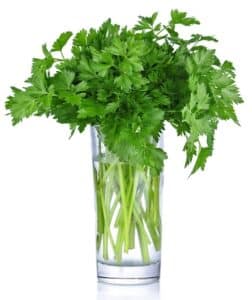 PARSLEY is a commonly used fresh herb that just doesn’t translate well into dried form. Fortunately, fresh parsley is easy to grow on the windowsill and is also available inexpensively year-round, so there is little reason to buy this nutritious herb in dried form. The fresh, mild herbal flavor of parsley is welcome in many culinary categories, including salads and salad dressings, soups, grain and bean dishes, casseroles, omelets, vegetable dishes, and herb breads. When buying parsley, choose the Italian, flat-leafed parsley for cooking, since it’s more flavorful, and reserve the use of the curly-leafed parsley for garnishing.
PARSLEY is a commonly used fresh herb that just doesn’t translate well into dried form. Fortunately, fresh parsley is easy to grow on the windowsill and is also available inexpensively year-round, so there is little reason to buy this nutritious herb in dried form. The fresh, mild herbal flavor of parsley is welcome in many culinary categories, including salads and salad dressings, soups, grain and bean dishes, casseroles, omelets, vegetable dishes, and herb breads. When buying parsley, choose the Italian, flat-leafed parsley for cooking, since it’s more flavorful, and reserve the use of the curly-leafed parsley for garnishing.
PEPPERCORNS are the whole, dried berries of an evergreen vine. Pepper is the second most commonly used seasoning after salt, not surprisingly, so its uses are too numerous, and too obvious, to enumerate here. It is worth noting, however, that it’s preferable to buy whole black or white peppercorns and grind them as needed than to buy pre-ground pepper. The difference in aroma and flavor is appreciable.
POPPY SEEDS are the tiny, round seeds of the beautiful and notorious opium poppy flower. The seeds contain none of the drug, but are thought to have a slightly calming effect. Poppy seeds come in colors ranging from white to gray to black, but the best ones are the darkest. Their nutty flavor makes them a special addition to spice cakes and seed cakes and an excellent topping for breads and rolls. In addition, poppy seeds are a nice seasoning for noodle dishes, cabbage dishes, casseroles, and dishes utilizing root vegetables such as parsnips.
RED PEPPER FLAKES come from the fruit of a pungent, fiery member of the Capsicum genus. Combining the seeds with the dried flesh of the pepper, this extremely hot spice is used in some of the incendiary dishes of India, Southeast Asia, Mexico, and in Cajun recipes from Louisiana. Even ¼ teaspoon added to an average recipe will yield quite a nippy result.
ROSEMARY is the slender leaves of a small evergreen shrub and has a well-known legacy in folklore as the herb of remembrance. You’ll certainly remember rosemary if you don’t use it sparingly, since its strong, piney flavor can be overwhelming. Rosemary is traditionally used to season lamb, chicken, and stuffing. In the vegetarian realm, it may be used to flavor vegetable stews, herb breads, and tomato soups or sauces.
SAFFRON, by far the most expensive of all spices, is derived from the dried, brilliant-yellow stigma of the autumn crocus. It lends its color to any food it touches; its flavor, on the other hand, is delicate. Saffron is primarily used in rice dishes, such as fruit-and-nut pilafs or the Spanish classic arroz con pollo, and is also utilized in some French and Middle and Far Eastern cookery and sometimes, but less commonly, in Indian cuisine. A common substitute for saffron is turmeric.
SAGE is the leaves of a small evergreen plant. Its strong, complex taste is best known as a flavoring for stuffing and sausages. When preparing foods such as TVP, tempeh, or seitan, all of which can be used as meat substitutes, seasoning with sage can add to the meatlike sensation. Sage may also be used, rather sparingly, in salad dressings, grain dishes (try it on wild rice pilaf) and soups, particularly pumpkin or squash soups. Dried leaf sage is preferable to ground sage.
SAVORY comes in summer and winter varieties that may be used interchangeably. Summer savory, an annual plant, is more widely available and has a milder, sweeter flavor than the perennial winter savory. Savory is a useful seasoning that imparts a subtle flavor that tastes like a cross between parsley and thyme. Use it wherever a mixture of dried herbs is called for (in salad dressings, herb breads, soups, and sauces) or as a milder substitute for thyme, oregano, or marjoram. Savory is known traditionally as the bean herb, because its flavor is thought to have a special affinity with most beans. Try it in bean soups and stews.
TARRAGON is an expensive herb best known for its role in making an elegant vinegar. It has a sharp-sweet, anise-like flavor and scent. Tarragon adds a distinctive touch to fresh green vegetables and green salads. Try sprinkling some on fresh peas, green beans, asparagus, or Swiss chard. Tarragon makes ordinary mayonnaise special and adds an unusual touch to omelets and tomato dishes. Tarragon is also used in the preparation of fish and chicken.
THYME is a popular herb related to the mints. Even when used sparingly, it imparts a vivid flavor and aroma. Thyme is an important seasoning in classic French and Creole recipes and is good used whenever a mixture of dried herbs is called for. Soups, vinaigrettes, grain and bean dishes, corn dishes, and tomato sauces all benefit from the distinctive flavor of thyme.
TURMERIC is the product of a dried, ground, fleshy root and is prized for its brilliant yellow color, much as is saffron, although turmeric is not nearly so expensive. This spice has a unique, rather “woodsy” flavor and scent and is almost invariably one of the main components of curry mixes. Use it to brighten rice pilafs, curries, corn dishes, pickles, and relishes.
- For lots more features on healthy lifestyle, explore VegKitchen’s Healthy Vegan Kitchen page.
- Here are more of VegKitchen’s Natural Food Guides.


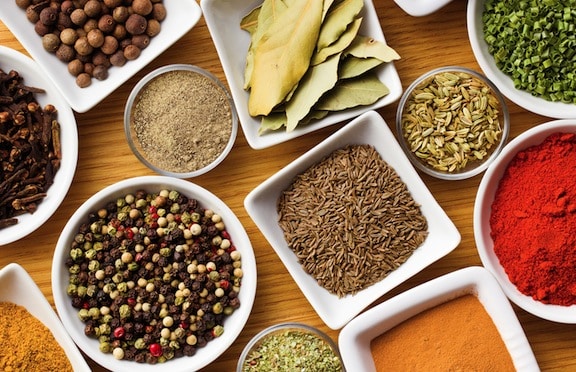
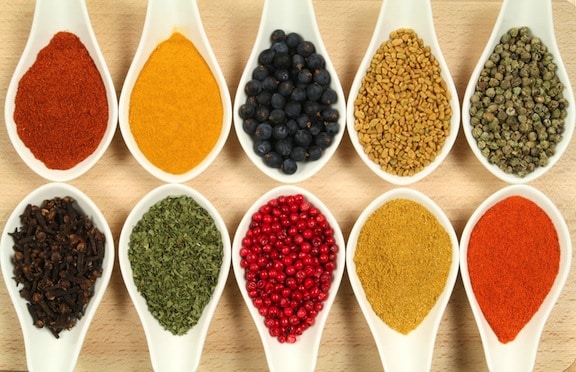
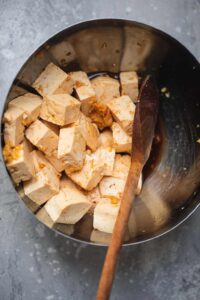

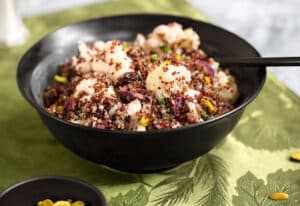

Anish gupta says
good information on culinary herb.
im growing for my own use at my farms.
DENNIS says
ho do i grow them for home use?
Nava says
Dennis, consult this post: http://www.vegkitchen.com/tips/seasonal-produce-guides/fresh-herbs-growing-buying-storing-and-enjoying/— in the section titled Growing Your Own, there's a link to a site that details how to grow herbs from seed to have indoors.
Lorraine Allen says
I've been searching for a book of some sort that will give a list of herbs and spices and what foods to use them with as I just love experimenting with foods and spices and herbs . Your pages is the nearest I have ever found
Lorraine Allen
Nava says
Thanks, Lorraine. Glad you found this useful. And I wish I knew of a good book on the subject to refer you to! If you finally find something, please leave another comment here.
M cummings says
Lovingly and well written too - many thanks!
Steve Burnstein says
Believe it or not I have been cooking off and on for 45 years and I still don't know how to mix spices in certain recipies. This site has given me hope. QUESTION: Can I mix, say, thyme, basil and oregano in a pasta sauce for a better taste?
Nava says
Absolutely, Steve! In fact, those herbs are a classic combination in pasta sauces. There are really no set rules with spicing foods up; it's a matter of using your own palate to arrive at flavors that taste good to you.
Louise says
This is a great list thank you. I had never heard of Mace before, now I am going to be on the look out. Would I have to buy them all fresh for a better taste, or are there some that taste just as potent if they've been stored?
Nava says
That's hard to say, Louise. Of course it depends very much on how long they've been stored, and how long since they were ground. Of course, the fresher, the better.
Tasie says
This is quite informative. I am fond of herb and spices. Parsley is my favorite - I use it a lot when juicing. It adds this awesome flavor to all my juice combos. I never gave thought to the dried herb, until you mentioned it above- always used it fresh.
Thanks for this insightful article.
Amarachi says
Wow! Good job and thank you for taking out time to do this. I have enough list to start my spice business. God bless you
Jesee says
Very grateful for the insight. I am a first year culinary art student and this comes across as very helpful. THANKS.
Bonni says
I was perusing your article, "Common Culinary Herbs and Spices" and spotted a typo under 'Dill Weed'. There needs to be a space between 'and' and 'casseroles'. As I have not read any farther in the article, I am not aware of any other errors. However, I am appreciating the article it seems to be informative.
Nava says
Thanks, Bonni — we always appreciate eagle-eyed readers; the sentence has been fixed.
Monisha Bharadwaj says
Wonderful information! For further reading, you may find my book The Indian Kitchen useful- it gives information about 100 ingredients of the Indian Kitchen including spices and herbs.
http://www.amazon.co.uk/Indian-Kitchen-Expanded-Monisha-Bharadwaj/dp/0781811430
david mlambo says
very handy and accurate educational insight into the world of herbs and spices
Peter says
I can't imagine a life without the wonderful tastes of herbs and spices. What is so good too is that so many of them have such positive effects on our health.
Anita says
We have most of those. I made a list of spices that we cook with. This is what's in our spice rack. What's in yours ? http://earthlychow.com/whats-in-your-spice-rack
Rachel says
Thanks for taking your time to put out this wonderful info.
Sandra says
My 15 yr old is Autistic, and we are on a culinary journey to develop his pallet. It has been so fun to watch his reaction to the newflavor each spice brings individually to a dish. But his eyes really light up when he starts being able to pick up the taste of single spices in the mixtures with food we have just made or ordered. The best trip of my life! To be sure!
cole says
great very helpful website! I needed herbs for school and this website came in handy!!!
Sugar says
That was great info and tells me more knowledge about cooking 🙂
Bowler says
Thank you , Very helpful, to use wher& when, help cooking.
Vennette Jones says
thank you so very much for this very informative page, For many years Ive mixed my own range of cooking spices using literally all the spices and herbs listed here and many friend , family and others who've heard of my mixes have bought my blends. Friends have encouraged me to package and market these, which Im currently working on. Im also in the process of writing a food journal which friends of forever asked me to do as I create nearly all my own cooking recipes and even give guidance and instruction on cooking and uses of herbs and spices ad their benefits.Im also attempting to write a blog post on word press but my site is not fully ready. The information you have provided will be a real good arsenal for me. Im from Jamaica where spices and herbs are a must in our cooking where some of these spices are also grown, you are blessed, thanks again.
Tony Kirby says
I am spice ignorant but for some time have been intrigued by them, Their uses, origination and or such. This 100% readable site has slaked my thirst for such knowledge. Very handy intelligence for dropping into dinner party conversation and astounding all (self included)
Paulomi says
This is so helpful. Like most Indians, I love spices and spicy food and to learn about the benefits of consuming spices only makes me feel better 🙂 Thanks.
Maggie says
This is really great guide to culinary spices; thanks for sharing! It's good to know that I shouldn't try stocking up too much with any spices since they lose their potency after awhile. Since I don't have a lot of experience in cooking, I'll be sure to grab a few of these options that I think I'll use.
Aedan says
Great article, packed full of great useful information, plus its quick and easy to read. Great Resource
Darrell says
Very useful descriptions about the taste and smell of different spices, thanks.
Tiffany Locke says
Buying only what will fit into an average-size spice jar is excellent advice. Having the right amount would be useful when storing your ingredients. I would imagine that if you use a certain spice mix more than others to suit your meal types, whether you like Chinese, Mediterranean, or Mexican food, you'd want to make sure you have more stocked up so that you always have what you need to cook your dishes.
Mehmet Tugay says
Great article, packed full of great useful information
Salma Rafayel says
Very nice and useful list of Culinary Herbs and Spices which i was looking for.